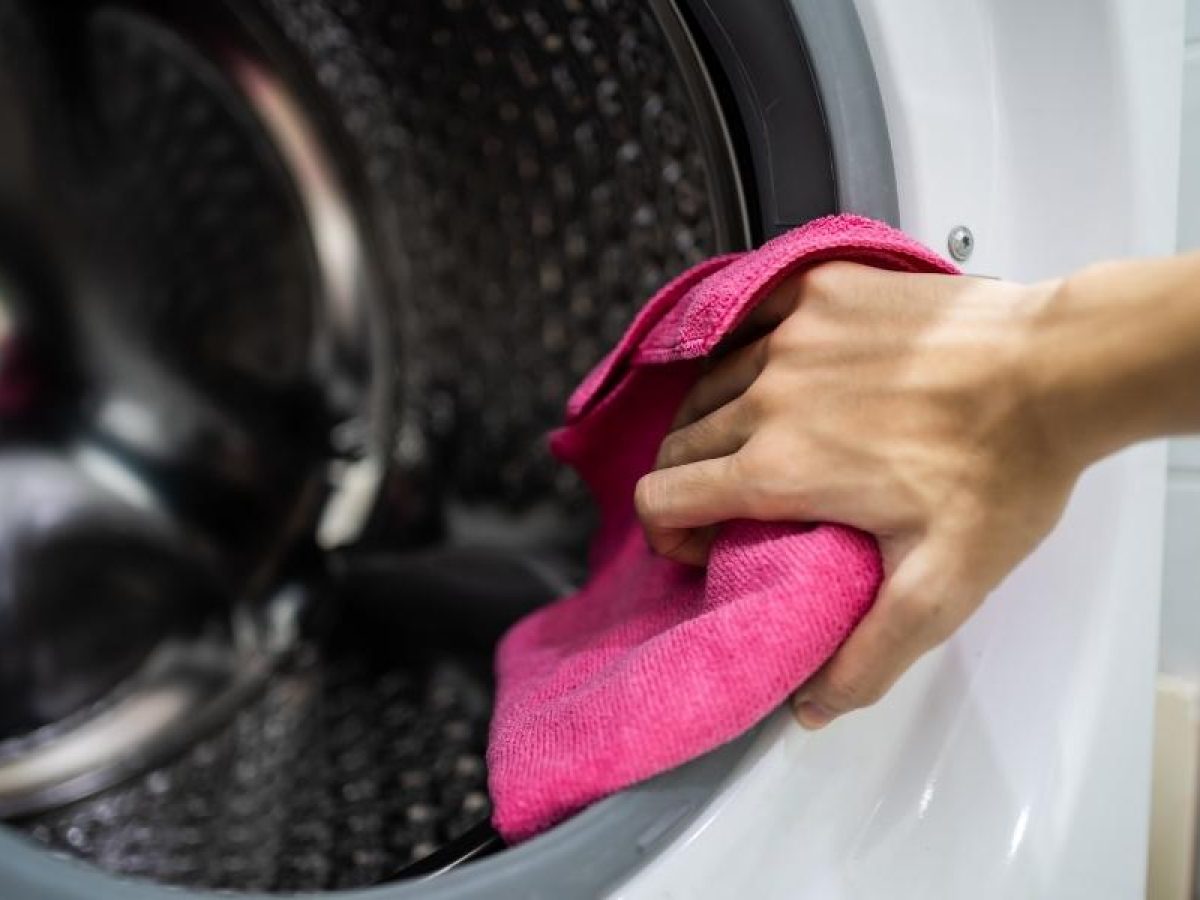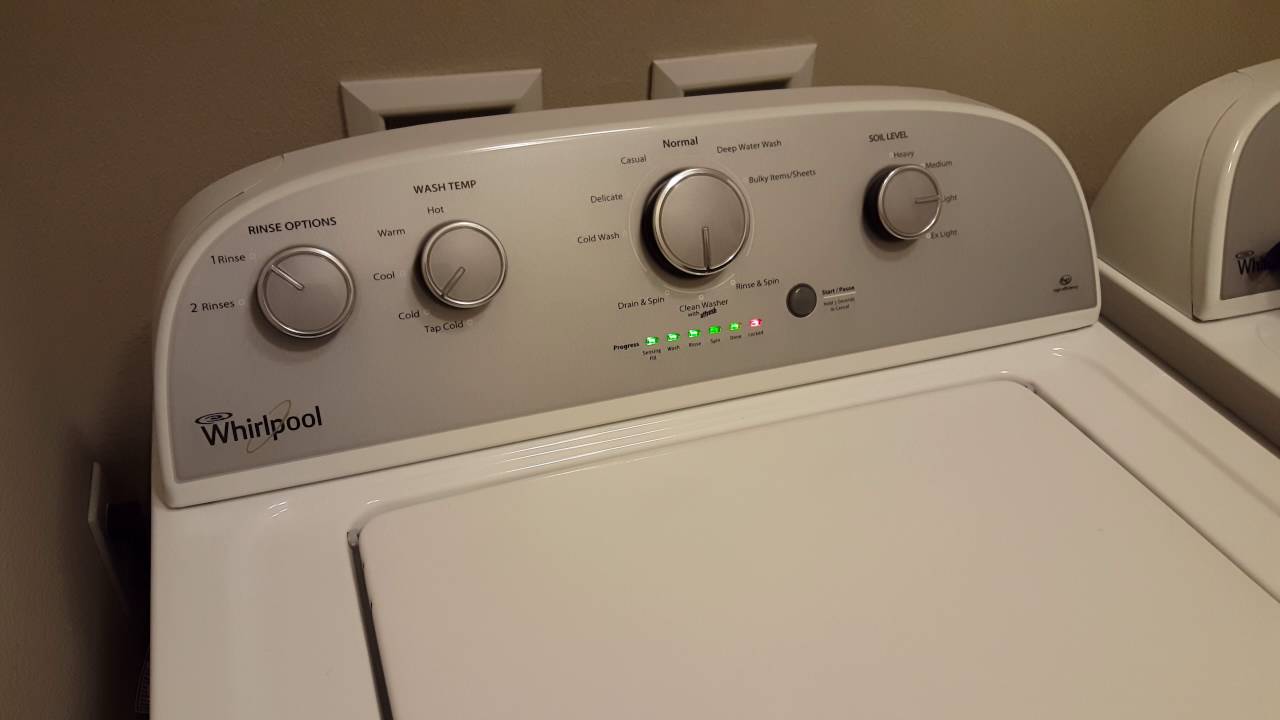Home>Home Appliances>Laundry Appliances>How To Wash Colors In A Washing Machine


Laundry Appliances
How To Wash Colors In A Washing Machine
Published: February 21, 2024
Learn the best techniques for washing colored clothes in a washing machine. Discover expert tips for maintaining the vibrancy of your laundry appliances.
(Many of the links in this article redirect to a specific reviewed product. Your purchase of these products through affiliate links helps to generate commission for Storables.com, at no extra cost. Learn more)
Understanding Color Fastness
Color fastness is a crucial factor to consider when washing colored clothes in a washing machine. It refers to the ability of a fabric to retain its color when exposed to various conditions, such as washing, light, and friction. Understanding the color fastness of your garments is essential to prevent color bleeding and fading, ensuring that your clothes maintain their vibrant hues for a longer period.
When purchasing new clothing items, it's advisable to check the care label for specific instructions regarding color fastness. These labels often provide valuable information on the recommended washing temperature, detergent type, and whether the garment should be washed separately or with similar colors. Additionally, the label may include symbols indicating the garment's color fastness to washing, which can range from a single dot for low color fastness to three dots for high color fastness.
By familiarizing yourself with these symbols and care instructions, you can make informed decisions when laundering your colored clothes. This knowledge empowers you to select the appropriate washing method and detergent, ultimately preserving the vibrancy and integrity of your garments.
Understanding the concept of color fastness also involves recognizing the potential risks of color bleeding. Garments with poor color fastness may release dye during washing, leading to color transfer onto other items in the load. To mitigate this risk, it's advisable to wash such garments separately or with similar colors to prevent unwanted dye transfer.
By comprehending the principles of color fastness and adhering to the care instructions provided for each garment, you can effectively safeguard the colors of your clothing during the washing process. This proactive approach not only preserves the aesthetic appeal of your wardrobe but also prolongs the lifespan of your favorite colored garments.
Key Takeaways:
- Prioritize color fastness and sorting by color to preserve the vibrancy of your colored clothes. Understand care labels and use appropriate detergents and wash cycles for effective color protection.
- Safely dry colored clothes to maintain their visual appeal. Air-dry in shaded areas or use low heat settings in the dryer to prevent color fading and fabric damage.
Read more: How To Reset A Washer
Sorting Clothes by Color
Sorting clothes by color is a fundamental step in maintaining the vibrancy and integrity of your garments during the washing process. This practice involves categorizing clothing items based on their color groups to prevent color bleeding and fading, ultimately preserving the visual appeal of your wardrobe.
When sorting clothes by color, it's essential to separate light-colored garments from dark or brightly colored ones. This precaution is crucial in preventing color transfer, especially when washing new or vibrant items that are more likely to release excess dye during the initial washes. By segregating light and dark colors, you minimize the risk of lighter garments absorbing dye from darker ones, thereby preserving their original hues.
Additionally, sorting clothes by color allows you to identify any heavily soiled or stained items that may require pre-treatment before washing. By isolating these garments, you can address stains individually, ensuring that they receive the necessary attention to achieve optimal cleaning results. This proactive approach not only enhances the overall cleanliness of your clothes but also minimizes the likelihood of stains spreading to other items during the wash cycle.
Furthermore, sorting clothes by color enables you to make informed decisions regarding the appropriate wash settings and detergent selection for each load. For instance, brightly colored or patterned garments may benefit from a gentle or color-safe detergent to maintain their vividness, while white or light-colored items may require a bleach alternative to preserve their brightness without compromising the integrity of the fabric.
By adhering to the practice of sorting clothes by color, you establish a systematic approach to laundering your garments, promoting effective color preservation and overall garment care. This simple yet impactful step contributes to the longevity of your clothing, allowing you to enjoy the enduring beauty of your favorite colored garments for years to come.
Choosing the Right Detergent
Selecting the appropriate detergent is a pivotal aspect of washing colored clothes in a washing machine. The right detergent not only ensures effective cleaning but also plays a significant role in preserving the vibrancy and integrity of your garments. When it comes to colored clothes, opting for a detergent specifically formulated for colors can make a notable difference in maintaining the brightness and preventing color fading.
Color-safe detergents are designed to be gentle on fabrics while effectively lifting dirt and stains from colored garments. These detergents are formulated to minimize color bleeding and fading, thereby safeguarding the visual appeal of your clothes. They often contain color-protecting agents that help lock in the dyes, preventing them from leaching out during the wash cycle. Additionally, color-safe detergents are typically free from harsh chemicals and optical brighteners, which can compromise the colors of your garments over time.
When choosing a detergent for colored clothes, it's essential to consider the specific needs of your garments. For instance, if you're washing dark or brightly colored items, opt for a detergent that explicitly mentions its suitability for these types of fabrics. Similarly, if you're dealing with delicate or heavily soiled colored garments, selecting a detergent with a gentle yet powerful formula can ensure thorough cleaning without causing damage.
Furthermore, it's advisable to avoid using bleach-based detergents or those containing bleach alternatives when washing colored clothes, as these products can lead to discoloration or fading. Instead, opt for detergents that are labeled as safe for colors and are formulated to maintain the vibrancy of your garments wash after wash.
By choosing the right detergent for your colored clothes, you prioritize the long-term preservation of their visual appeal and structural integrity. This proactive approach to detergent selection not only enhances the cleanliness of your garments but also contributes to the sustained beauty of your colored wardrobe, allowing you to enjoy your favorite garments for years to come.
Selecting the Appropriate Wash Cycle
Selecting the appropriate wash cycle is a crucial step in ensuring the effective cleaning and preservation of colored clothes in a washing machine. Modern washing machines offer a variety of wash cycles, each designed to cater to specific fabric types and soil levels. When it comes to colored garments, choosing the right wash cycle can significantly impact the cleanliness and longevity of your clothes.
For colored clothes, the gentle or delicate wash cycle is often the most suitable option. This cycle is characterized by shorter wash times, reduced agitation, and lower spin speeds, making it ideal for maintaining the integrity of delicate fabrics and preserving the vibrancy of colors. The gentle wash cycle minimizes the risk of excessive friction and stretching, which can be detrimental to the appearance and structure of colored garments. Additionally, this cycle is typically accompanied by a lower water temperature, which is beneficial for preventing color bleeding and fading, especially in more delicate or brightly colored items.
In instances where colored clothes are lightly soiled, the quick or express wash cycle can be a practical choice. This accelerated cycle is designed to deliver a rapid yet effective cleaning process, making it suitable for garments that require a swift refresh without prolonged exposure to the wash cycle. However, it's important to note that the quick wash cycle may involve higher spin speeds, so it's advisable to use this option for garments that can withstand such conditions without compromising their colors or structural integrity.
For heavily soiled colored items, the regular or normal wash cycle can provide the thorough cleaning they require. This standard cycle typically involves longer wash times and increased agitation, effectively tackling stubborn stains and dirt. When utilizing the regular wash cycle for colored clothes, it's essential to ensure that the water temperature is appropriate for the fabric type and colorfastness of the garments. Additionally, using a color-safe detergent in conjunction with the regular wash cycle can help maintain the vibrancy of the colors while achieving optimal cleanliness.
By carefully selecting the appropriate wash cycle for your colored clothes, you can optimize the cleaning process while safeguarding the visual appeal and longevity of your garments. This thoughtful approach to wash cycle selection ensures that your colored clothes receive the tailored care they deserve, allowing you to enjoy their enduring beauty with confidence.
To wash colors in a washing machine, use cold water and a gentle detergent to prevent fading. Turn clothes inside out to protect the color and use a gentle cycle to avoid damage.
Using Cold Water for Color Protection
Using cold water for washing colored clothes is a strategic approach that significantly contributes to the preservation of vibrant hues and prevents color fading. Cold water, typically defined as water at temperatures below 80°F (27°C), offers several benefits when laundering colored garments.
Cold water is particularly effective in safeguarding the colors of delicate or brightly colored fabrics. When compared to hot water, which can cause dyes to leach out from the fabric, cold water minimizes the risk of color bleeding during the wash cycle. This is especially crucial for new or heavily saturated garments, as cold water helps lock in the dyes, preventing them from transferring to other items in the load.
Furthermore, cold water is gentle on fabrics, reducing the likelihood of shrinkage and preserving the structural integrity of the garments. Unlike hot water, which can cause certain fabrics to contract and lose their shape, cold water minimizes the impact of thermal stress on the fibers, ensuring that the garments retain their original fit and appearance.
In addition to color protection, using cold water offers environmental and cost-saving advantages. Cold water washing consumes less energy compared to hot water, contributing to reduced energy consumption and lower utility bills. This eco-friendly approach aligns with sustainable laundry practices, making it an appealing choice for individuals seeking to minimize their environmental footprint.
When washing colored clothes in cold water, it's essential to pair this approach with a suitable detergent formulated for cold water use. Cold water detergents are designed to dissolve effectively in lower temperatures, ensuring thorough cleaning without leaving behind residue or causing color fading. By combining cold water with a compatible detergent, you can achieve optimal cleaning results while preserving the vibrancy of your colored garments.
In summary, utilizing cold water for washing colored clothes is a practical and impactful method for color protection and fabric care. This approach not only safeguards the visual appeal of your garments but also aligns with sustainable and cost-effective laundry practices, allowing you to maintain the beauty of your colored wardrobe with confidence.
Read more: How To Drain A Kenmore Washer
Avoiding Overcrowding in the Washing Machine
Proper loading of the washing machine is essential for ensuring thorough cleaning and preserving the colors and integrity of your garments. Overcrowding the washing machine with an excessive amount of clothes can compromise the effectiveness of the wash cycle and lead to potential damage to the fabrics. By adhering to the recommended loading capacity and avoiding overcrowding, you can optimize the cleaning process while safeguarding the visual appeal and longevity of your colored clothes.
When the washing machine is overloaded, the water, detergent, and fabric interaction may become insufficient, resulting in inadequate cleaning. This can lead to the ineffective removal of dirt, stains, and detergent residue from the garments, impacting their overall cleanliness. Additionally, overcrowding restricts the movement of the clothes during the wash cycle, hindering proper agitation and rinsing. As a result, some garments may not receive adequate exposure to water and detergent, compromising the thoroughness of the cleaning process.
Furthermore, overcrowding can cause increased friction and entanglement among the garments, potentially leading to fabric abrasion, stretching, or distortion. Delicate fabrics, in particular, are susceptible to damage when subjected to overcrowding, as the excessive friction and pressure can cause pilling, snags, or deformation. Additionally, tightly packed clothes may not have sufficient space to release soil and detergent residue during rinsing, leading to incomplete removal and potential re-deposition onto the garments.
To avoid overcrowding in the washing machine, it's important to adhere to the manufacturer's recommended loading capacity, which is typically based on the weight of the laundry. By following these guidelines, you allow adequate space for the clothes to move freely during the wash cycle, promoting optimal cleaning and minimizing the risk of damage. Additionally, separating larger items such as bed linens or towels from clothing items can prevent overcrowding and ensure more effective cleaning for all items in the load.
By prioritizing proper loading and avoiding overcrowding in the washing machine, you enhance the cleaning efficiency and garment care, ultimately preserving the visual appeal and longevity of your colored clothes. This mindful approach to loading contributes to the overall cleanliness and maintenance of your wardrobe, allowing you to enjoy your favorite colored garments with confidence and satisfaction.
Removing Stains Before Washing
Removing stains before washing is a proactive and effective approach to ensuring thorough cleaning and preserving the visual appeal of colored garments. Addressing stains prior to the wash cycle not only enhances the cleanliness of the clothes but also minimizes the risk of stains setting in and becoming more challenging to remove. By incorporating stain removal into the pre-wash routine, you can optimize the cleaning process and maintain the pristine condition of your colored clothes.
The first step in removing stains before washing is to identify the type of stain and the fabric composition of the garment. Different stains, such as oil-based, protein-based, or tannin-based, may require specific treatment methods to achieve optimal removal. Additionally, understanding the fabric type allows for the selection of appropriate stain removal products and techniques that effectively target the stains without compromising the integrity of the fabric.
For oil-based stains, such as grease or makeup, applying a small amount of dishwashing liquid or a pre-treatment stain remover directly to the affected area can help break down the oils before washing. Gently massaging the product into the stain and allowing it to sit for a few minutes can enhance its effectiveness in loosening the oils from the fabric fibers.
Protein-based stains, including those from food, blood, or sweat, may benefit from pre-soaking the garment in cold water with the addition of an enzyme-based stain remover. Enzyme-based products are designed to target and break down protein-based stains, facilitating their removal during the wash cycle. Pre-soaking the garment allows the stain remover to penetrate the fibers and begin the stain-lifting process before the actual washing process begins.
Tannin-based stains, such as those from coffee, tea, or wine, can be treated with a combination of white vinegar and water. Diluting white vinegar with water and dabbing the solution onto the stain can help neutralize and lift the tannin-based discoloration from the fabric. This gentle yet effective approach can significantly improve the success of stain removal for tannin-based stains.
In addition to targeted stain removal methods, it's essential to address any visible stains promptly to prevent them from setting into the fabric. Allowing stains to linger without treatment can lead to them becoming more ingrained, making them harder to remove during the wash cycle. By promptly attending to stains and utilizing appropriate stain removal techniques, you can increase the likelihood of achieving complete stain removal and maintaining the pristine appearance of your colored garments.
By incorporating stain removal into the pre-wash routine, you can effectively address stains and enhance the overall cleanliness and visual appeal of your colored clothes. This proactive approach to stain removal not only contributes to the thoroughness of the cleaning process but also ensures that your garments remain in impeccable condition, allowing you to enjoy their enduring beauty with confidence.
Drying Colored Clothes Safely
Drying colored clothes safely is a critical step in maintaining the vibrancy and integrity of your garments after the washing process. Proper drying techniques not only contribute to the overall care of your colored clothes but also play a significant role in preventing color fading, shrinkage, and fabric damage. By adhering to safe and suitable drying methods, you can ensure that your colored garments retain their visual appeal and structural integrity for prolonged use.
One of the most effective and gentle ways to dry colored clothes is by air-drying them. This method involves hanging the garments on a clothesline or drying rack in a well-ventilated area, allowing them to dry naturally. Air-drying is particularly beneficial for delicate or brightly colored fabrics, as it minimizes the exposure to heat and friction that can contribute to color fading and fabric distortion. Additionally, air-drying is an eco-friendly and cost-effective approach, as it reduces energy consumption and minimizes the risk of damage associated with mechanical drying methods.
When air-drying colored clothes, it's essential to avoid direct sunlight, especially for brightly colored or patterned garments. Prolonged exposure to sunlight can lead to color fading, particularly in fabrics that are more susceptible to UV damage. Instead, choose a shaded or indoor drying area to protect the colors and maintain the vibrancy of your garments. Additionally, gently reshaping the garments while they are damp can help preserve their original fit and appearance, preventing any potential distortion during the drying process.
For individuals who prefer machine drying, using a low heat setting is crucial for drying colored clothes safely. The low heat setting reduces the risk of excessive heat exposure, which can cause color fading and fabric damage, particularly in delicate or brightly colored items. Additionally, adding a few clean, dry towels to the dryer load can help absorb excess moisture and reduce drying time, promoting a more gentle and efficient drying process for your colored garments.
It's important to promptly remove the colored clothes from the dryer once the drying cycle is complete to prevent wrinkles and potential heat-related damage. Hanging or folding the garments immediately after drying can help maintain their smoothness and shape, ensuring that they are ready to wear without the need for additional ironing or steaming.
By prioritizing safe and suitable drying methods, you can effectively preserve the visual appeal and structural integrity of your colored clothes. Whether air-drying or using a dryer, implementing these thoughtful approaches contributes to the overall care and maintenance of your colored garments, allowing you to enjoy their enduring beauty with confidence and satisfaction.
Frequently Asked Questions about How To Wash Colors In A Washing Machine
Was this page helpful?
At Storables.com, we guarantee accurate and reliable information. Our content, validated by Expert Board Contributors, is crafted following stringent Editorial Policies. We're committed to providing you with well-researched, expert-backed insights for all your informational needs.















0 thoughts on “How To Wash Colors In A Washing Machine”